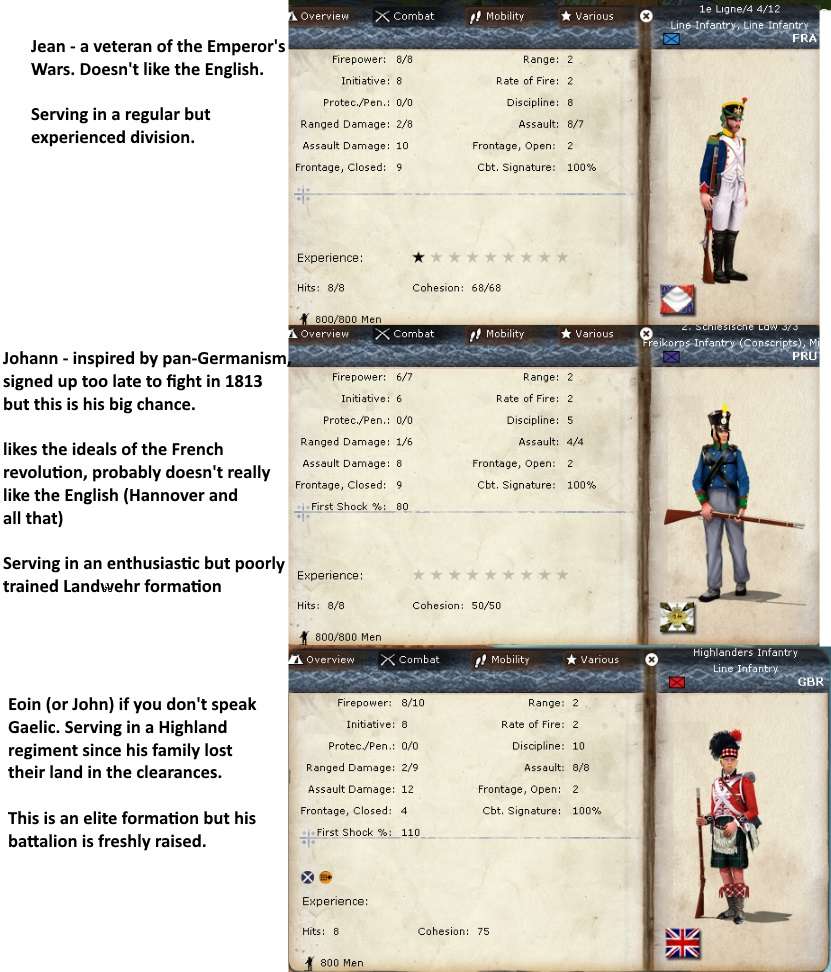As in the other posts, for more details, you are strongly advised to read the AGE Wiki. Equally you can play well on the basis of common sense. The 'power' score you see for a stack is a good guide to relative effectiveness as it is built up from cohesion and potential firepower. However, it helps to have some idea of what is going on below this level of aggregation. That may help you tailor forces for certain situations and in your unit building strategies.
In this post I will discuss some aspects of the combat model but I'll leave issues like frontage and which elements fight (and how) to another post.
As a start we are going to meet three somewhat different infantry men.

Before going on to the details, should say those numbers are the base rates for each unit type. They can be affected by other units in the stack, terrain, whether fighting in own province, leadership and entrenchments.
So lets work down from the top.
There are two firepower scores. The first is used when the unit is the attacker and the second if the unit is the defender. So both Johann and Eoin are actually slightly better on the defence but this makes no difference to Jean.
So this is the first way in which the aggregated power score may be misleading. Some units are better either as the attacker or defender but that score is simply an average.
But what does the number mean?
Simple for every 1 point of firepower the unit has a 4% chance to hit the target. So Eoin on the defence has a 40% chance of landing a hit.
Next is initiative. If the units come up against each other in battle this determines who fires first. Johann is going to risk being shot before he can actually fight back.
Then protection. Note this is 0 for all but can be improved by terrain and entrenchments. This score is subtracted from the firepower score to determine the actual chance to hit. As befits the organised nature of Napoleonic warfare most line formations are relatively easy to hit.
Important, skirmishers give a +1 to avoid being hit to all other units in the same formation. Make sure each division etc has at least one.
Ranged Damage is what happens if the unit makes a hit. The first number is outright losses and the second is in terms of cohesion. Note that if Johann is still alive (remember he probably got to shoot second), he inflicts far less damage than his opponent.
Assault Damage replaces the firepower score when we come down to bayonets and close range fire (again the chance to hit is this number *4/100). Again Johann (assuming he is still alive) is not going to be very effective.
Frontage, we'll ignore for now as its best discussed in the context of how many elements you can deploy on the battlefield.
Range is when the unit can first fire. Weather and terrain depending, a battle can open at range 4. All our brave souls fire at the same range.
Rate of Fire is how often can the unit fire in a given combat round. This can be severely reduced by lack of command and a stack with a 35% command malus will only fire once.
Discipline is tested to see if the unit will engage in an assault. An excellent guide to this part of the battle can be found on the AGEOD forums. For the moment, all that really matters is that the chance of a unit completing an assault is the base number/10.
Note that both Eoin and Johann have a line First Shock. This modifies the discipline test the first time they fight close quarters. Clearly Jean asked Eoin if anything was worn beneath the kilt [1]. Johann is going to struggle to get off this battlefield alive.
Assault is the relative damage outright kills/cohesion that is inflicted in the assault phase.
So we start to see that sending in militia (no matter how keen they are) into open combat is not a good idea. For all that Johann's unit contributes to the notional combat power you see, in reality he will perform far worse than that aggregated score might imply.
Just to complete this lets look at how an artillery and a cavalry unit differ. Both are Russian from the start of the game.

On the defence note the artillery is much more powerful – it has 44% chance to hit and inflicts a lot of cohesion losses. If it comes into close combat, it is very unlikely to miss (60% chance to hit). It also opens at range 5. So at the start of a battle, an artillery rich army will inflict losses when the opposing infantry can't respond. So by the time the battle lines close, the weaker side will have had a lot of cohesion losses.
Our chosen cavalry is a dragoon. So has some protection and can do some damage at range. Its in the assault phase that cavalry is most dangerous.
Now armed with this information, we can look in more detail at what goes on when the stack selection phase is completed and battle commences - a later post.
[1] The answer, according to Carry on up the Khyber, is 'nothing, its all in perfect working order'.

